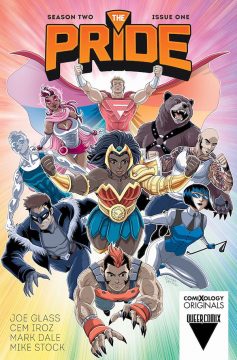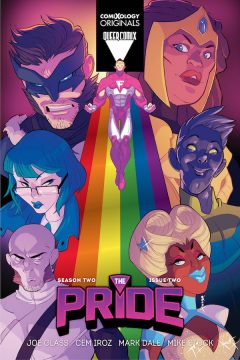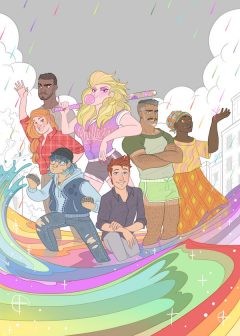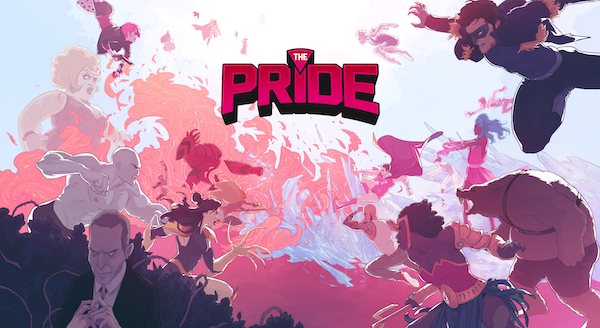“If The Pride was me bringing gay pride to comics, Glitter Vipers is me bringing GAY RAGE” Joe Glass talks to Monty Nero about The Pride, Glitter Vipers and more!
We always mention how amazing the UK comic scene is at supporting each other, and so we are delighted to bring you a fantastic collaboration between Death Sentence’s Monty Nero and The Pride’s Joe Glass. The two have sat down to talk inspirations, the state of the UK scene and the recent news that Joe’s book The Pride is going to be published by Dark Horse Comics. Read on to see what else these two indie comics titans have to say:
 Monty Nero: You’ve had some exciting news about The Pride recently. Do share.
Monty Nero: You’ve had some exciting news about The Pride recently. Do share.
Joe Glass: Indeed! My LGBTQ+ superhero series, The Pride, is coming to print for the first time since the series was picked up and extended with ComiXology Originals. The print collection, a mammoth omnibus collecting everything (and I mean everything), is being made by legendary comic publisher Dark Horse Comics, and will be released in time for Pride Month 2021! I’m super excited. We’ll have Diamond Order Codes nearer the time, but people should definitely make sure their local comic store knows about it, and book stores can already preorder too, I believe.
MN: What was your original hope and inspiration for The Pride?
JG: I just wanted to tell stories where people like me and my friends could feel seen and be the heroes. Superheroes in my favourite genre, but finding LGBTQ+ representation in it as I grew up was almost non-existent. I had to rely more on analogies and metaphors, which is why X-Men became my safe haven during some of my toughest times growing up. But the thing with only ever being able to see yourself in metaphors and allegories is it starts to feel like another kind of closet: like the very nature of who you are cannot be talked about, even in the context of a fictional story of mutants and aliens and people running faster than the speed of light.
So the goal was to make a superhero world where the main cast were all LGBTQ+ and try to give as much of the community as possible the air they were gasping for. And also, to maybe become that safe haven that the next generation of young queer readers to find solace and hope in. Paying it forward, but trying to do better too, by being open and straight up honest.
And hopefully, one day, I would love to see the series spun off into multiple books and creators, each building on their own corner of both the fiction and their community.
MN: How did it change as it was created?
JG: I think one thing I’ve noticed recently is that a lot of folks think The Pride is a comedy: that’s not how I see it, and perhaps that is a failing on my part. But the core thing that springs FabMan into action in the first season of The Pride is not wanting to be seen as, or his community treated as, a joke anymore. I include humour in The Pride, of course, because the way I’ve always seen the world is you can either laugh or cry, and frankly I’d rather laugh. I mean, even the darkest tales have moments of light-heartedness and comedy, and that’s part of what I was going for – The Pride overall is bright, colourful and positive, and has humour to it, but it’s not a comedy. This is a story about big damn heroes to me, and it always has been. I think that’s something that has gradually become more clear in later issues of the series, and what I want to explore going forward.
 How did the Comixology Originals thing come about?
How did the Comixology Originals thing come about?
JG: Well, as some know, for a time I was also a reporter for Bleeding Cool (and actually several other websites and magazines), and I used to travel to US cons like SDCC and NYCC as part of that. Around the same time, I was putting the self-published issues of the first season of The Pride on ComiXology thanks to their wonderful Submit platform, that allows independent and small press creators to put their comics on the app. Pretty early on, several people at ComiXology took notice of The Pride, and they learned I was coming to one of these US cons, and asked me to speak on a panel about my Submit experience. Through that, I got to meet them and found they were really supportive not just of comics but of comics with a message and by under-represented people, and they are just some of the coolest folks.
Years later, they announced they were getting into the comics making game with Originals, and I took my shot and asked if they would be open for me to pitch and thankfully they were. I pitched The Pride Season Two as part of that very first pitch meeting and the rest, I guess, is history.
MN: And I’m also looking forward to Glitter Vipers which you’re making as we speak. How’s that progressing?
JG: Great! We’re actually almost ready to go to press, we’re just doing the finishing touches and last pages, and we’ll be off to the printers. And of course, people will be getting their digital copies soon too.
MN: Tell us more about the Glitter Viper’s world and story?
JG: Something I said recently actually probably touches on it well. If The Pride was me bringing gay pride to comics, Glitter Vipers is me bringing GAY RAGE. I am, generally, a positive, hopeful, bright person, but in recent years, man…that takes work. There’s a lot of anger, caused a lot by how people in my community are treated, and that’s what Glitter Vipers deals with.
More specifically, it follows a drag queen named Bi Phallicia, who forms a queer street gang with their friends after they get attacked by homophobes on the streets of Manchester’s Gay Village. They form the Glitter Vipers to fight back against a rise in hate crimes and bigotry by kicking its ass. Because sometimes, you see the world outside and the way some people hurt others in it, and you just want to smash it all with a sequined baseball bat.
 MN: And it’s led to a bonus pin campaign?
MN: And it’s led to a bonus pin campaign?
JG: Yes, we’re live now as a matter of fact! I normally make pins too as part of campaigns, but I wasn’t sure what to do with Glitter Vipers when the book’s campaign was running. And I love me some enamel pins. I am a highly addictable collector, and these gorgeous little trinkets you can wear and display? Love them. So I came up with an idea to make something super fabulous and got it priced up and launched a small campaign to cover it (the original campaigns funds are all allocated after all). Also, to be honest, after the original campaign ended, I had a bunch of folks saying they missed it (I don’t know how, I was blabbing about it daily for thirty days lol), so this is a good second chance for folks wanting to preorder Glitter Vipers too.
MN: What else have you got in the works?
JG: I’m working with Vince Underwood, Harry Saxon and Hassan Otsmane-Elhaou on a new book called The Miracles. We’re going to launch that on Kickstarter, either later this year or early next year (I’m very cautious of launching a campaign too close to the holidays), which is about a family of superheroes. Think The Incredibles meets The OC, with some Invincible thrown in.
I also have several pitches out there at several places that I hope will get picked up. We’re talking horror, sex comedies, romance and of course, more superheroes.
MN: What’s your creative process like, on a good day.
JG: I’ll let you know when I have one, ha!
Nah, on a good day, I’ll just be furiously typing away. I can often bash out a full 24-page comic in a given day when my brain is playing ball with me and the ideas are flowing well. I am awful for doing that though, as that can burn you out, and sometimes it does for me. I’ll smash out an issue or two in a day, and then won’t be able to do anything for a couple. But when I get in the zone, I find it hard to pull myself back.
MN: And on a bad day?
JG: Yeesh, far too often these. Honestly, on a bad day I may not write anything creatively. I’ll catch up on emails and other aspects, such as campaign management or pricing things up etc. Sometimes I’ll just be bugging editors to see if there’s any movement on a pitch (sorry editors!). But even on those days, I try to make some notes. Even just loose things that may wind up becoming something later or I just needed to get out of my head.
MN: What do you recommend we check out? Any writers or artists you recommend?
JG: Okay, books to read…there’s actually a ton lately, so I won’t necessarily say why, or we’ll be here all day, so I’ll just rattle some titles off and honestly people HAVE to check them out: Department of Truth, Giga, Barbalien, Commanders in Crisis, Crowded, Immortal Hulk, X-Factor, The Impending Blindness of Billie Scott, Trve Kvlt, It Took Luke, IND-XED, Something is Killing the Children, We Only Find Them When They’re Dead, Alienated…
Oh, and if you have not been reading John Constantine: Hellblazer, especially if you’re a British reader, you have really done a crime upon yourself. The first trade, Marks of Woe, is available now, and best found in comic shops.
As for creators, I think everyone is watching Zoe Thorogood, who is going to be huge. But also keep your eyes peeled for the likes of Liana Kangas, Vita Ayala, and names to keep in your pocket: Oliver Gerlach and Hagai Palevsky.

MN: What are your thoughts on the comics scene in general right now?
JG: I mean, this is difficult to answer right now due to the pandemic. There feels like there is no physical scene to speak of, at least for me. I live in South Wales, with few comic creators close to me, or at least, close enough that we can see each other within lockdown restrictions. Even outside of all this, it can feel quite isolating, as the majority of the more close knit comics making communities are based in bigger cities like London and Leeds. That being said, the creativity that is being put into work right now is off the charts. I think 2021, when all things being equal we can see each other again, we’ll see people bursting forth with more exciting projects and ideas than we ever thought possible. The energy is there, it’s just under the surface created by this whole crisis right now. But you can see a lot of it on Kickstarter and online, so I can’t wait to see it hit the real world soon.
MN: How did you first ‘get in’ to comics?.
JG: You mean in the British sense of ‘started to like’ or in terms of ‘how did I break in’? The former, I think I grabbed a comic at a camping site supermarket in France on a family holiday when I was five, and I became instantly addicted to the medium. For the latter, well, it depends on your definition of ‘breaking in’. It’s something I’ve been thinking about recently: ‘breaking in’ is entirely dependent on what your personal definition of what that looks like is.
For me, I’d argue I haven’t broke in yet. I’ve made waves, I’ve made my presence known, but in terms of the traditional comics industry, I am not in yet. But that’s because my dream is to write for Marvel and DC someday, and that hasn’t happened. Yet. I think there’d be a lot who’d agree with that assessment, as I think many asking that question are specifically thinking about the Big Two.
However, I am making comics. It was well liked enough by not just one but two publishers for them to pick it up and help me make it. So there’s also the argument that I have ‘broken in’ and really all I did to do that was simply make comics. It’s an age old answer that feels as unhelpful as it’s shortness implies, but it really is the case.
You can have the best ideas in the world, but if people can’t see you action them, why should they take the risk on you? You want to ‘break into comics’, whatever that means to you? The only way is to just make comics.
MN: Which comic or character did you love most when you were ten, eighteen and now?
JG: Hmmm, when I was ten (so we’re talking about the years of ’84-’94), it was probably Cyclops or Beast, but I only knew them from the cartoon at that point. I wasn’t a regular collector or reader yet, just the odd comic…and X-Men reading became more voracious a couple of years later when the comics started appearing in my local newsagents.
When I was 18 years old, it was a toss up between Spawn and Dream from Sandman. I was going through a darker phase, and oscillated between moody anger or moody existentialism.
Now? The characters that excite me most are those with worlds that feel new to me. So I love Naomi and Jo Mullein over at DC. But also, Pixie from X-Men, just because she’s Welsh too.
MN: If you were given your dream comics job what would you write, what would you change, and what would you cancel?
JG: I think everyone knows it would be an X-Men title, probably like a Young X-Men. I pitched it in the past, but it didn’t fit with where the X-Office at the time was taking the characters. Maybe someday…
If I was to change anything, I’d want to see more genre bending at the Big Two. Books like Immortal Hulk and Far Sector have been so exciting purely because the bend the kind of stories being told in those formats.
I tend not to think about books I’d cancel – I can’t get my head to go that way. Sure, there are books I don’t like, but someone else out there probably does. Also, I’m bad at thinking of things in a commercial way, I can’t imagine canceling anything because i just like the stories and content being created, period. I mean, hell, when an absolute work of genius of Hellblazer can get its run not continued because of sales numbers, I think that’s a goddamn crime, to be honest.
Joe Glass is a comics writer from the deepest, darkest South Wales Valleys in the UK. He is mostly known for his ComiXology Originals, LGBTQ+ superhero series, The Pride, Acceptable Losses, and Glitter Vipers. You can find his work here and on comixology here. He’s a freelance writer available for hire too, so if you are an editor/publisher, feel free to get in touch at his website.
Monty Nero is a prize winning comics scholar and writer/artist published by Marvel, DC, Titan, Delcourt, 2000ad and others. You can find his new comic with Image artist Yishan Li here


